#I have the highest int mod with a +0
Explore tagged Tumblr posts
Text
Funny dnd thing that happened
Bloodhunter: oh no, they found in I’ve been cursed with lycanthropy! I have to run away before they kill me in hatred
The rest of the party: hey why’d the furry run off?
#we Don’t Know and Don’t Care#she turned into a wolf#kicked our enemies butts#then ran off#literally all we know#we’re fuckig. stupid#I have the highest int mod with a +0#dnd#dungeons and dragons#text post
42 notes
·
View notes
Text
Tabletop Tuesday: Stars Without Number by Kevin Crawford
For this Tabletop Tuesday, I’d like to talk about the TTRPG Stars Without Number by Kevin Crawford.
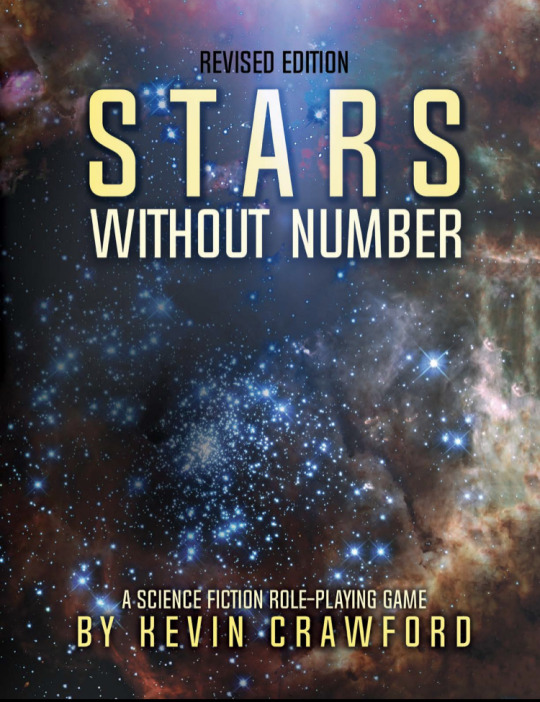
Setting
SWN is a spacefaring sci-fi TTRPG set in the distant future. On Earth in 2108, the spike drive, a device that allows faster-than-light travel, was invented. Soon humanity became a spacefaring race, colonizing space in an era called the First Wave.
In 2240, some children started to develop something called “Metadimensional Extroversion Syndrome”, or MES, which allowed them to channel metadimensional energy with their minds; Psionics.
Psionics were quickly harnessed and used to advance humanity, leading to pretech and psitech, highly advanced technology thrusting humanity forth with their colonial efforts. The Jump Gates, massive rings powered by choirs of psychic teleporters, allowed humanity to spread further than they previously could.
But the Second Wave wouldn’t last. In 2665, a massive wave of metadimensional energy swept over all of human space, and all psychics were killed or driven to madness. The Scream was followed by the Silence, the Jump Gates inoperable, the colonies cut off from the core worlds, humanity fell quiet.
The game take 600 years after the Silence, as humanity begins to pick itself up again.
Rules
SWN is modeled after old-school TTRPGs like those crafted by the old TSR crowd.
Characters have six attributes: Strength (Str), Dexterity (Dex), Constitution (Con), Intelligence (Int), Wisdom (Wis) and Charisma (Cha). To determine them, you either roll 3d6 and assign them in order, then if you want change one number to 14, or you can use the array of 14, 12, 11, 10, 9, 7 assigned as you wish. The score of the attribute determines its modifier (mod), which is used in skill checks, attack rolls, and saving throws.
A character has three saving throws: Physical (15 minus better mod of Str or Con), Mental (15 minus better mod of Wis or Cha), and Evasion (15 minus better of Dex or Int).
Characters also have a background, which you use to determine your skills. Skills and backgrounds are pretty simple, the only thing you should know is that skills have levels which you use to add to checks along with the pertinent attribute modifier. There are also psychic skills, which I will get into later.
Then you have your character’s class. There are three classes: Warrior, Expert, and Psychic, as well as the fourth class, Adventurer, which is more of a special group of dual-classes (Warrior/Psychic, Expert/Warrior, Psychic/Expert). There’s more classes in expanded material but we needn’t get into that here.
Warriors have and extra 2 Hit Points (HP) and a 1st level attack bonus of +1, get one extra level in a combat-related focus (I’ll get into that later) and once per scene (encounter) as an Instant action, they can turn a missed attack roll into a hit.
Experts get one extra level in a non-combat-related focus, and upon leveling up get a bonus skill point to spend on any non-combat, non-psychic skill. Once per scene, Experts can reroll a failed skill check.
Psychics are able to learn psychic disciplines and techniques, and get two psychic skills as bonus skills (you can pick the same skill twice to make it level-1). Psychics have an Effort score equal to 1 plus their highest psychic skill level, plus the better of their Wis or Con mods, with a minimum of 1 Effort.
Adventurers are a mix of two classes, and thus get abilities depending on the classes they partially belong to.
Partial Warriors get a free level in combat focus, a +1 attack bonus at 1st and 5th level, and +2 HP per level.
Partial Experts get a free level in a non-combat focus, and an extra skill point each level for a non-combat, non-psychic skill.
Partial Psychics get one psychic discipline as a bonus skill at level-0, and cannot learn or improve any other psychic skill. They have an Effort score equal to 1 plus their psychic skill level, plus the greater of their Wis or Con mods.
Now, Foci. Each character gets one focus during creation. A focus is a particular trait or talent of the character that sets them apart. Foci have levels which determine how powerful they are. Some foci are ones like Die Hard (makes it tougher for the character to be killed) or Sniper (makes certain shooting attacks more deadly).
Before we go to equipment, let’s talk Psionics.
Psionics are an important part of SWN. Psychics and Partial Psychics can harness metadimensional energy to use in a variety of ways, divided into the six disciplines. Each discipline is represented with a psychic skill that the Psychic must train. Within these disciplines are many techniques which are what Psychics actually do in the game rules. Techniques are powered by Effort, which is Committed to a technique for the time specified, ranging from just for a moment to the entire day. It returns after the technique is completed. If a Psychic runs out of Effort, they can Torch, which gives them an extra Effort point for the rest of the scene, but often at the permanent detriment to their attribute scores. Here are the six psychic disciplines:
Biopsionic techniques deal with living creatures. They can heal and repair as well as harm and debilitate.
Metapsionic techniques alter the Psychic’s other techniques and power over psychic energy itself.
Precognitive techniques deal with prediction of future events and the altering of them.
Telekinetic techniques manipulate matter, and are often useful and powerful in combat.
Telepathic techniques concern those of mind-reading, brainwashing and thought broadcasting.
Teleportative techniques move matter from one place to another nigh-instantaneously, once used in the Jump Gates.
Now, onto equipment. You can either choose an equipment package (preselected equipment, useful for quickly-made characters) or receive 2d6x100 credits to spend. Equipment will be extremely important to our next topic: Scenes.
Scenes are times in the game where the GM might require the players to roll some dice, either as saving throws, skill checks or as part of combat.
Saving throws are easy enough. When the GM requires a saving throw, you roll 1d20 and try to beat or match the given score, usually your pertinent saving throw, possibly modified if the GM so wishes.
To make a skill check, you must roll 2d6 and try to beat or match the check’s difficulty, set by the GM. You can add your pertinent attribute mod and skill level to the check. If an ally attempts to help, they make a check too (it doesn’t have to be the same, negotiate with your GM), and if they succeed, they add +1 to your check.
Combat is a bit more complicated. First, everyone rolls 1d8 for initiative, adding their Dex mod. This determines the order of actions of the round, highest goes first, lowest goes last. One side of the conflict might be surprised, depending on the situation, in which they do not act for that round.
In the round, on your turn, you can take one Main Action and one Move Action, as well as any amount of On Turn Actions. Instant Actions may be taken anytime, any amount of times. Main actions are your typical attacks and skill checks. Move actions concern movement, On Turn actions are quick but only on your turn, such as dropping to the floor or dropping an item, and Instant actions are your split-second reflexes.
Attacking requires an attack roll to hit. To do so, you roll 1d20, modified by your attack roll bonus or other modifier determined by your GM. If you match or beat the required score, you hit the target and deal damage, determined by whatever you are attacking with.
There are more rules to speak of, such as Hacking and Starships but most are either variations of the rules shown above, or are GM rules I needn’t list here.
Conclusion
Stars Without Number is a game that is easy to get into, with its fairly simple rules, and quite freeing to run, drawing from the old-school TTRPGs many adore. I would highly suggest checking it out. There’s a free copy available legally online!
Thanks for reading, hope you enjoyed!
2 notes
·
View notes
Text
My D&D Build for Wolf

Tough, strong, and no nonsense, Wolf has survived in post-apocalyptic world on her own since she was a young age. Raised by wolves, she knows how to fight fiercely like one with her trusty weapon she lovingly calls Stalky. For a time, Wolf was the main fighter of the group until Kipo comes into her own as part Mute.
Long Post Below

***Stats***
Dexterity: Highest stat. After watching Wolf in action, I’m going to say that her dexterity is her number one stat as she avoids getting hit long enough to deliver a devastating blow. Don’t worry, you’ll have plenty of opportunities to increase her Strength which leads us to . . .
Strength: Second Highest. Wolf is pretty strong for her size, but will break skulls with Stalky.
Wisdom: Third Highest. Wolf is street wise or apocalyptic wise to the dangers of the surface world. She can see danger coming and knows how to avoid or deal with it one way or another.
Constitution: Fourth Highest. This girl has survived for a long time despite the odds against and also, she handles a still poison scorpion stinger so she must have develop some resistance to it.
Charisma: Fifth Highest. Low because Wolf doesn’t easily open up to others though she does warm up to Kipo eventually.
Intelligence: Dump Stat. Wolf has trouble understanding the purposes of modern items of the pre-apocalyptic world.

For her race we’re going with Variant Human. Put her two ability score points into Dexterity and Strength.
For the Feat: Choose Alert since Wolf is always on the lookout for danger. Wolf cannot be surprised unless she’s unconscious and she gets +5 to her initiative roll. Also, hidden enemies cannot get advantage on attack rolls on her.
For Skill: Choose Acrobatics. Wolf is pretty nimble.

We’re going start off in Fighter for this build.
***Fighter Level 1***
For skills choose Survival as Wolf has had to take care of herself in the wilderness and post-apocalypse cities. And choose Perception as Wolf is always on the look out for danger and notices things the group fails to see.
Weapon: This took some thought and since Wolf mostly uses Stalky as a bludgeoning weapon so use the states for a Maul, or you can use a Pike for piercing damage. You can talk to you DM about giving you the option to use piercing with a sleep poison that the target would need to make a saving throw against.
Fighting Style: The best one for Wolf would be Great Weapon Fighting. When Wolf fights with a two handed weapon (Stalky), she can reroll any 1 or 2 on the damage die and take the second result.
Wolf also gets Second Wind which will let Wolf to heal herself for 1d10 + Fighter level per short or long rest.
***Fighter Level 2***
Wolf gets Action Surge which will allow her to take another action on top of her action and bonus action. Can be done once after a short or long rest.
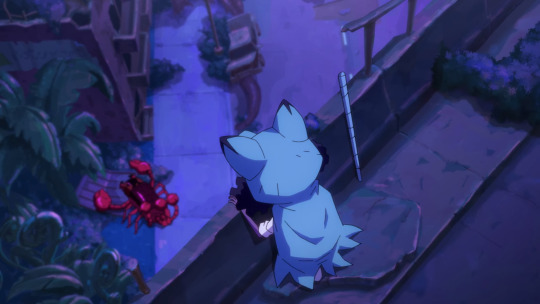
***Fighter Level 3***
For Martial Archetype, we’re going with Monster Hunter (UA). Wolf has grown up fighting mutes for most of her life. Which gives her Superiority Dice.
She gets 4 1d8 dice that she can use to make her attacks deal more damage and gives her an edge to determine potential dangerous situations. She regains all the dice back after a short or long rest.
She can spend a dice to add a 1d8 to:
Precision Attack: For an weapon attack, she can add a 1d8 to an attack roll before or after she rolls it,
Sharpened Attack. When she lands a hit with a weapon attack, she can add a 1d8 to the damage. If the attacks forces the target to make a Constitution saving throw to maintain concentration on a spell or ability saving throw, it must roll at disadvantage.
Sharpened Senses: When Wolf rolls Perception to find a creature or hidden object or Insight to determine if someone is lying, she can add a 1d8 to the roll. Can be added after the roll, but must be applied before determining if the check succeeded or not.
Superior Willpower: Wolf can add a 1d8 to a Intelligence, Wisdom, or Charisma saving through. Like when she saw through Tad Mulholland’s illusion.
She also gets two additional skills for proficiency bonus. Select Nature and Insight.
On top of all of this, she can use two spells. As a Ritual, she can cast Detect Magic to see magical auras and after a short or long rest, she can cast Protection from Good or Evil. I know she never casts spells in the show, but these are useful additions if the need should arise.

***Fighter Level 4***
Ability Score Improvement: Usually, I would be telling you to max out her main Ability Scores, but in this case I’m going to recommend a Feat instead.
Great Weapon Master: Whenever she scores a critical hit with a melee weapon or reduces a creature to 0 hit points from an attack, she can use her bonus action to perform another melee weapon attack!
Also, she can take a -5 to her attack roll to deal additional +10 points of damage!
Wolf is fast, dealing multiple attacks to overwhelm her enemies. Anyone you can take an additional attack works for her.
***Fighter Level 5***
Extra Attack: Wolf can now perform 2 attacks when she takes the attack action! Even better when coupled with Great Weapon Master feat.
***Fighter Level 6***
Ability Score Improvement: Okay, this time start maxing out Dexterity.
***Fighter Level 7***
Monster Slayer: Wolf can spend two Superiority Dice instead of just one.
***Fighter Level 8***
Ability Score Improvement: This time max Dexterity. If it’s already maxed out, put the points into Strength.

***Fighter Level 9***
Indomitable: Once per long rest, Wolf can reroll a failed save, but must take the second roll. It’ll help in seeing through false fantasies and illusions brought on by water mutes.
***Fighter Level 10***
With Improved Combat Superiority Wolf’s superiority dice are now 1d10s allowing her to hit more often and deal more damage. Not to mention overcoming any mind manipulation.
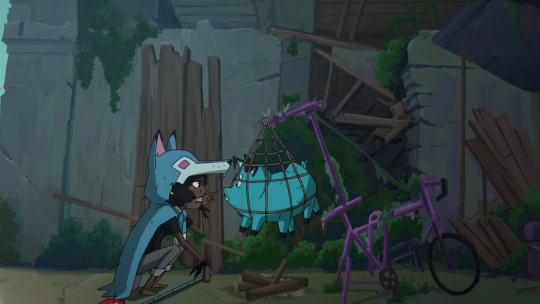
Now we’re going to dip into Ranger (UA). I considered going full Fighter, but Wolf has been surviving on her own for years which means finding her own food and mapping out territories. Not to mention she fights mutes on a daily basis.
***Ranger Level 1***
For Wolf’s Favored Enemy since there’s no mutes int the game (unless you DM is coming up with a special homebrewed setting) select monstrosities. Wolf gets a +2 to damage on weapon attacks on favored enemy. Also she gets advantage on Survival checks to track or recall information about them. Wolf knew where the Mod Frogs were and how to negotiate with them. She also new about Newton Wolves and other mutes.
Also, she’s a Natural Explorer - she can ignore difficult terrain, advantage on initiative rolls, on her first turn in combat, she has advantage on attack rolls against enemies who haven’t acted yet.
She also function as the group’s guide. The party isn’t slowed by difficult terrain and cannot be lost except by magical means. Also, Wolf gains twice as much food when she forages. When she’s tracking creatures, she can determine thier group number, size, and how long ago they had pass through the area.

***Fighter Level 11***
Extra Attack (x2): Wolf not gets two extra attacks. Meaning she can take THREE attacks per attack action. Potentially four with Great Weapon Master, if she crits or reduces a creature to 0 hit points and uses her bonus action to attack. Not to mention if she uses an Action Surge to attack, that’s five attacks in one turn!
***Fighter Level 12***
Ability Score Improvement: If Dexterity is maxed out, put points into Strength.
***Fighter Level 13***
Wolf now has two uses of Indomitable per long rest.
***Fighter Level 14***
Ability Score Improvement: Max out Strength. If it’s already maxed out by now put the extra points into Wisdom or round out your odd number ability scores.
***Fighter Level 15***
Relentless: Wolf is a tough fighter. When she starts combat with no Superiority Dice, she automatically regains one!
***Fighter Level 16***
Ability Score Improvement: Max out Strength and/or round out odd number ability scores.
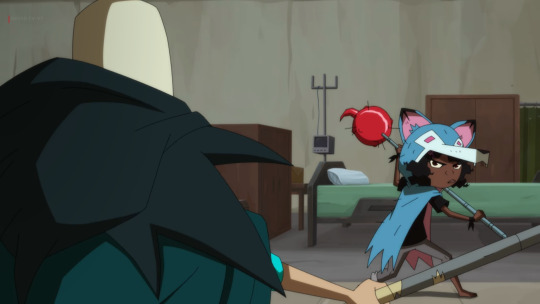
***Fighter Level 17***
Wolf is not to be underestimated. She now gets two Action Surges per short and long rest and three Indomitable rerolls per long rest.
***Fighter Level 18***
Improved Combat Superiority: Wolf’s Superiority Dice are now 1d12s. She’s more efficient in serious battles and a force to be reckoned with.
***Fighter Level 19***
Ability Score Improvement: Dexterity and Strength should be maxed out by now. If all the other points are rounded out, put these last two points into Wisdom.

There you have it. Wolf from Kipo and the Age of Wonderbeasts.
With a high Dexterity, she’s fast and hard to hit in combat while able to deliver several blows per round. With Superiority Dice to help out in a pinch, she’s scrappy and tough enough to deal the final blow. Also, she’s resistant against mutes with mind control powers. With the level in Ranger, she can lead the group to safety while navigating dangerous territory.
The only downside would be that her Hit Points might be a little low, but if she’s hard to hit, then she shouldn’t take damage that often. However, having a healer to back her up in combat wouldn’t hurt or give her a certain partner or Best Friend.
Next up is Kipo herself!
4 notes
·
View notes
Photo

Checkout our new post over at http://lichlair.com/daily-monster-11-kraul-warrior
Daily Monster #11: Kraul Warrior

Today we talk about our second Ravnica setting monster. Before we start, I would like to once again ask all hardcore MtG readers to take the following article with ta grain of salt. With that out of the way, let us begin discussing…
The Kraul Warrior
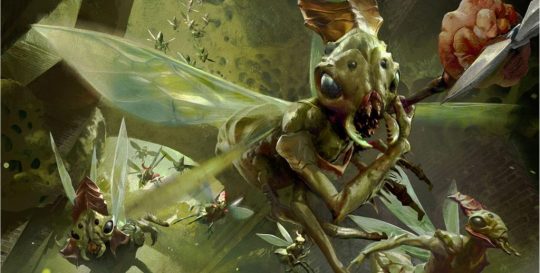
The basics
Kraul have a -1 CHA, +0 to WIS and INT, and a +1 to DEX, with their highest stat being allocated to STR for a total +2 mod to it.
They’re considered medium humanoids with a Darkvision of 60ft, an AC of 18, and 5d8+5 hit points. Oh, and they also have a climbing speed of 30ft.
Okay, so maybe not quite like Kobolds but hear me out; after your players are done fighting Kobolds, consider making them fight some Kraul.
Kraul are immune to charm and frightened thanks to their Hive Mind ability, have access to pack tactics, and as mentioned before, possess a Spider Climb feature as well.
In terms of attacks, unfortunately Kraul lack variety with only a Spear attack option. However, this is nothing that a little homebrewing can’t fix.

The Lore
As with Blood Witches, I unfortunately wasn’t able to find too much on these creatures. But even some of this missing information might serve us well when brainstorming encounters for the Kraul.
Kraul are an insect-like race of humanoids that inhabit the deepest darkest corners the the underbelly of Ravnica. If there’s something that we can definitely tell at a glance from what little information there is about these creatures is that they function in an army like manner. Their society appears to be organized in some sort of caste system that most Kraul tend to be secretive about.
Although usually reserved and considered outliers, because of their affinity with insects, mold, and such, Kraul can very often be found as outspoken members of the Golgari Swarm.

The Execution
After looking through their stats, I have to say that Kraul kind of remind of slightly meatier Kobolds from Ravnica.

….
Okay, maybe not Kobolds, but, after your players are done fighting those tiny lizards maybe consider throwing a few of these their way. Alternatively if you have a higher level party, just throw a literal swarm of them their way and enjoy the chaos. Look… I just really really really like creatures that can use terrain in interesting ways. What’s better than a creature that can just walk up the ceiling and use their reach weapon to gently poke at your player characters with?
Kraul also come in flying variety that you could use to add a little extra oomph. These creatures have a flying speed of 40ft and are considered a higher standing within their society, often serving as the guild scouts and shock troops rather than plain militia.
It could be that your party accidentally stumbles into a hidden society of Kraul that inhabits a remote region of your world. This could either be underground or even some sort of fungi forest. Perhaps your adventurers are sent with the intention of meeting these being to establish some sort of truce, or perhaps the Kraul are being forced into civilization by some sort of unknown threat that the players are meant to investigate and resolve. The beauty of these creatures is that there really isn’t much known about their secretive societies. Go wild.
Whichever of these you choose, make sure to let us know how it played out for your party by dropping us a message in our forums. If you liked this article and would like to be notified whenever we post new content, consider following us on our social media.
0 notes
Text
Python GCD – 4 Ways to Find GCD or HCF
Here I will show you 4 different ways to find GCD in Python using program examples.
GCD also known as HCF (Highest Common Factor). So let’s see how we’ll do it.
Method 1: Using Loop
n1 = 48 n2 = 36 #find smaller if(n1>n2): smaller = n2 else: smaller = n1 #getting hcf i = 1 while(i<=smaller): if(n1%i==0 and n2%i ==0): hcf = i i = i+1 print("hcf = ", hcf)
Output:
hcf = 12
So in this program, first we assign values to n1 and n2, then we’ll find smaller number from both of the numbers. After that we’ll start loop from 1 to smaller number to find a number which can be fully divisible with both of the numbers n1 and n2 and store into a new variable named as hcf. At the end of the loop we’ll get the highest number stored in hcf variable which can fully divide both of the numbers n1 and n2. That highest number will be our hcf.
Method 2: Using Recursion
def find_hcf(n1,n2): if(n2==0): return n1 else: return find_hcf(n2,n1%n2) n1 = 48 n2 = 36 hcf = find_hcf(n1,n2) print ("highest common factor = ", hcf)
Output:
highest common factor = 12
So here we have a recursive function which receive two arguments and return the Highest common factor between them.
Method 3: Using math.gcd()
import math n1 = 48 n2 = 36 hcf = math.gcd(n1,n2) print("Highest Common Factor = ", hcf)
Output:
Highest Common Factor = 12
Python has an inbuilt method to find out the GCD. We even doesn’t need to think how to code to find GCD. All we have to do is just use math.gcd() method and it will return the GCD.
Method 4: Using Euclidean Algorithm
Euclid’s algorithm, is an efficient method for computing the greatest common divisor (GCD) of two numbers. Here is the pseudocode to show how we can find GCD using Euclidean Algorithm.
Pseudocode:
function gcd(a, b)
while b ≠ 0
t := b;
b := a mod b;
a := t;
return a;
Program:
#implementing Euclidean algo def get_gcd (x, y): while(y): x, y = y, x % y return x n1 = 48 n2 = 36 hcf = get_gcd(n1,n2) print("Highest Common Factor = ", hcf)
Output:
Highest Common Factor = 12
In this program, get_gcd(int, int) function is used to implement the Euclidean algorithm. For more details on Euclidean algo please visit https://en.wikipedia.org/wiki/Euclidean_algorithm
If you’ve any problem or suggestion related to python gcd programs then comment down below.
The post Python GCD – 4 Ways to Find GCD or HCF appeared first on The Crazy Programmer.
0 notes